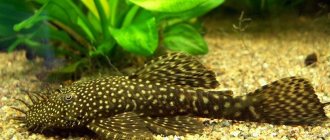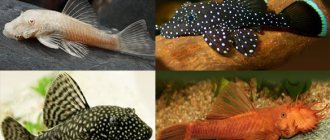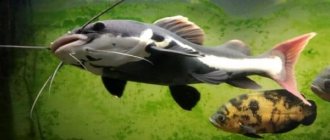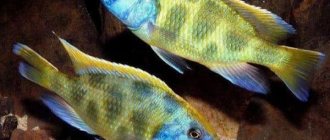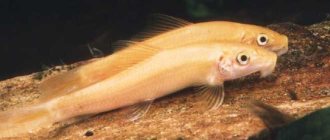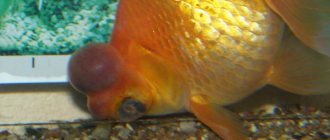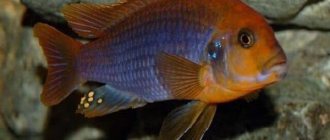Veiled ancistrus photo can be enlarged
Ancistrus is a common aquarium fish. The reason for its popularity is rather the originality of the pet than its decorative qualities. This fish is a suction cup and moves in leaps and bounds, fixing itself with its mouth transformed into a suction cup to glass, plants and stones. In addition, the mouth is equipped with horn-shaped scrapers that allow you to clean various fouling from various objects in the aquarium, glass, stones, plants.
Habitat and appearance
In nature, Ancistrus vulgaris is mainly distributed in the northern and central parts of South America. It can live both in stagnant lakes and in rivers with fairly fast currents. The body, covered with a shell of keratinized plates, resembles half a drop of water, cut lengthwise. But it’s better to look at the photo for the shape and color. Adult specimens in aquariums reach 10 centimeters. The maximum dimensions depend on temperature and decrease as it increases. Ancistrus are usually not kept separately; they are placed in common aquariums as a cleaner.
Various variants of this popular fish have been bred in captivity. In addition to the common ancistrus, a veil form has appeared, characterized by an increased size of the tail and fins. As usual, there are albinos, whose bright yellow specimens are called golden ancistrus. Star ancistrus is distinguished by more contrasting white dots on a dark background. All these varieties can be seen in the photo on the left.
Reviews about Ancistrus
Mikhail, review of the golden ancistrus
Fabulous catfish! Grew from a 1.5 cm fry to an 8-9 cm catfish. Very beautiful, undemanding, cleans glass perfectly. He lived with corydoras in a 30-liter jar, now with Malawian cichlids “mbuna” in a 280-liter “fight club”, in which not everyone without Malawian citizenship will survive. In addition to the Malawians, he is adjacent to a pterygoplicht, about 20 centimeters long. No problem. Bright yellow, with a beautiful brush of whiskers, crawls on glass and stones, eats algae. Before it appeared among the Malawians, I cleaned glass every week with a scraper, but now I’ve forgotten what it is. 280 liters - copes. I’ll repeat about his appearance: even with beautiful Malawians, he doesn’t get lost, but decorates the aquarium. I recommend to all!
Grew from a 1.5 cm fry to an 8-9 cm catfish. Very beautiful, undemanding, cleans glass perfectly. He lived with corydoras in a 30-liter jar, now with Malawian cichlids “mbuna” in a 280-liter “fight club”, in which not everyone without Malawian citizenship will survive. In addition to the Malawians, he is adjacent to a pterygoplicht, about 20 centimeters long. No problem. Bright yellow, with a beautiful brush of whiskers, crawls on glass and stones, eats algae. Before it appeared among the Malawians, I cleaned glass every week with a scraper, but now I’ve forgotten what it is. 280 liters - copes. I’ll repeat about his appearance: even with beautiful Malawians, he doesn’t get lost, but decorates the aquarium. I recommend to all!
CASH, review of star ancistrus
Very beautiful. Although the size of the spots does not change with age, the fish remains very colorful. Disadvantages: Gentle beast. It is better not to take it into a fresh aquarium, there is a high probability of death 
Alenka, review of Ancistrus vulgaris
A peaceful fish, it hides in the shade during the day, when it spits out it looks very beautiful. The nice thing is that she is unpretentious. I have two of them. When I went on vacation in the summer, they went into hibernation - they went without food for almost a month. When there is not enough air, they are not particularly worried - although sometimes they vomit when there is a lack of oxygen (once they even broke a light bulb near an aquarium with their tail). I took them small, and in a couple of years they grew big: one was about 10 cm, and the other was 13 cm. And they continue to grow. So it looks very impressive against the background of light soil.
Mine love to dig. Although I feed them generously. Due to such activity, plants (which are shallowly planted and not pressed down by anything) are often pulled out. Small fish sometimes clean them, so there have been cases of careless contact, which ended disastrously for small fish.
These are probably my favorite fish, because they are large and unpretentious. They also blink coolly and polish the aquarium.
They also blink coolly and polish the aquarium.
Maintenance and care
Golden photo can be enlarged
Ancistrus catfish is quite simple to keep. The fish is peaceful and gets along well in almost any freshwater tropical aquarium with a temperature of 22-26 C. It can withstand temperature changes from 18 to 33 C. In aquariums it has adapted to almost any composition of water, although in nature it lives mainly in slightly acidic water. Loves clean, oxygenated water. Therefore, intensive aeration of water is desirable, in the flows of which ancistrus prefer to stay.
The aquarium should be fairly densely planted with plants and contain various shelters in which these fish like to be. It is desirable to have driftwood, which these catfish happily scrape.
Albino photo can be enlarged
The male Ancistrus is exterritorial and actively defends the chosen shelter. The fish are crepuscular and are most active in the evening. They feed on various foulings from all surfaces of the aquarium. If there is a shortage of food, they may begin to scrape the plants and spoil them, especially young shoots. They partially feed on leftover food from other inhabitants of the artificial reservoir.
If there is a group of ancistrus or they are kept in a small aquarium, additional feeding of these animals with plant food is necessary. You can use scalded lettuce or cabbage. Industrial food for herbivorous fish in the form of tablets is also suitable.
Possible problems
Although ancistrus are very unpretentious and quite peaceful creatures, keeping them can cause some problems. One of the main difficulties is that the home pond has a limited area. If there is a lack of free space, adult catfish may show aggression within their species to defend the territory. Their fights are rarely very brutal, but a stronger individual will not give the opponent the opportunity to calmly feed on its territory, which can lead to the death of the weak fish.
Another problem is the wrong neighborhood. Sticky catfish are nocturnal creatures; they can “mount” larger sleeping fish, such as goldfish, and gnaw off their scales.
It happens that ancistrus can crawl into the filter tubes, which can lead to their death.
Ancistrus are susceptible to various gastrointestinal diseases, as well as viral or bacterial diseases associated with their appearance. Worms can disturb catfish. To avoid most problems, you should not introduce new fish into a community aquarium right away. They are kept in quarantine for several days and their condition is monitored. If signs of the disease appear, you should consult a specialist to choose a treatment method.
Ancistrus, due to its high adaptability and unpretentiousness, get sick extremely rarely.
The only common disease is bloating, which most often occurs due to poisoning with chemicals or food.
Feeding
Ancistrus veil photo can be enlarged
The aquarium fish Ancistrus loves to eat and needs a lot of food. The main diet is plant-based; spirulina-based foods, which are available in tablets, are well suited. The tablets dissolve slowly in water and have an attractive odor for Ancistrus vulgaris. You can also add vegetables, which will significantly expand their diet. Hungry ancistrus eat pieces of zucchini, mugs of cucumbers and lettuce leaves to the ground. Broccoli and many other types of vegetables are also loved. But do not forget to remove uneaten food debris to avoid water rotting!
If you expect to get offspring from your Ancistrus, you should feed them frozen food. Their delicacies include bloodworms and correts, and they can ignore other types of live food. Since the fish feed from the bottom, make sure that there is easy access to the food, otherwise they simply will not notice it.
The simplest solution to ensure the normal functioning of ancistrus is to add driftwood to the aquarium. And the gastrointestinal tract needs legnin to digest food. And almost all species of catfish get it by scraping wood from snags. A sufficient amount of driftwood will allow them to remain active and healthy.
Aquarium stickers or cleaner catfish
Features of catfish - suckers
Ancistrus
Ancistrus is native to the central and northern parts of the South American continent. Its maintenance is not very difficult even for beginner aquarists. At the same time, the catfish has a very unusual appearance. In addition to the simple ancistrus, star and black (dark) ancistrus are of interest to aquarists. There are albino and veiled forms. Catfish raised in the wild can reach 15 cm in length. Aquarium specimens are noticeably smaller. To maintain it you need an aquarium of 80 liters or more.
When purchasing ancistrus, it is worth remembering that these fish love clean and sufficiently oxygenated water. They will also like the current in the aquarium. However, its absence does not cause discomfort in fish. The optimal water temperature is 22 - 26°C. But they can safely tolerate short-term decreases or increases in temperature.
Ancistrus feed on fouling from almost all surfaces of the aquarium. And therefore, many aquarists keep them as a kind of cleaner. But of course, their diet should also include complete food for sucker fish. It is quite possible to diversify their diet with some vegetables and herbs. Lettuce, pumpkin, cabbage, and cucumber are quite suitable. It is important not to forget to remove the remains of such food from the water in a timely manner. Otherwise, this may become too serious a test for the ecological balance in the aquarium.
Otocinclus
Glyptoperichthus
Sturisoma
Compatibility
These catfish can be kept with virtually all types of aquarium fish; in fact, they are peaceful inhabitants of the aquarium bottom. However, it is impossible to say that Ancistrus is an absolutely harmless fish! Yes, everywhere - in RuNet articles they write that these catfish behave like “God’s dandelions”, but on aqua forums you can often find information that ancistrus chase fish, pester them and even spoil the skin. And it is true! Therefore, it is not advisable to keep them with slow and clumsy fish, for example, with the goldfish family. Also, you should not keep them with scaleless fish, for example, with sacbranch catfish; ancistrus can cause serious wounds to such fish with their “passionate kisses.”
Ancistrus are not compatible with large, aggressive and territorial cichlids, especially during the spawning period.
Ancistrus: maintenance, compatibility, breeding, photo-video review of catfish suckers, stickers
Ancistrus are the most popular catfish in the aquarium world! Everyone knows them and maintains them, both beginners and pros. Ancistrus have earned such attention due to their qualities: they are classified as “aquarium orderlies”, they are unpretentious in maintenance, extraordinary in behavior and, of course, the structure of their sucker mouth noticeably distinguishes them from many other catfish-like fish.
Feeding any aquarium fish should be correct: balanced, varied. This fundamental rule is the key to the successful keeping of any fish, be it guppies or astronotuses. The article “How and how much to feed aquarium fish” talks about this in detail; it outlines the basic principles of the diet and feeding regime of the fish.
In this article, we note the most important thing - feeding fish should not be monotonous; the diet should include both dry food and live food. In addition, you need to take into account the gastronomic preferences of a particular fish and, depending on this, include in its diet food either with the highest protein content or, conversely, with plant ingredients.
Popular and popular food for fish, of course, is dry food. For example, you can constantly and everywhere find food on aquarium shelves - the leader of the Russian market; in fact, the range of food for this Tetra is included as individual food for a specific type of fish: for goldfish, for cichlids, for loricariids, guppies, labyrinths, arowanas, discus, etc. .d. Tetra has also developed specialized foods, for example, to enhance color, fortified, or for feeding fry. You can find out detailed information about all Tetra feeds on the company’s official website - here .
It should be noted that when purchasing any dry food, you should pay attention to the date of its manufacture and shelf life, try not to buy food in bulk, and also store the food in a closed state - this will help to avoid the development of pathogenic flora in it.
There are a lot of varieties of Ancistrus! Below is a description of the most popular variety of this loricarian catfish.
ANCISTRUS VEIL
Video about veiled ancistrus
Video with Ancistrus: spawning and more
Reproduction
Black ancistrus photo can be enlarged
Breeding Ancistrus catfish is quite simple. Males differ from females by the presence of “horns” - leathery processes on the head. In females they are absent or weakly expressed. In addition, males are slimmer. Under good keeping conditions, these fish can lay eggs even in a community aquarium if they find suitable shelter. But the fry in this case are unlikely to survive.
When purposefully breeding ancistrus, both pair and group spawning is used. In the latter case, a group of 2 males and 4-6 females is used for breeding. A mandatory condition for reproduction is the presence of shelters in a spawning aquarium with a volume of 40 liters or more. It is best to use ceramic or bamboo tubes of suitable diameter. But you can also use stones and driftwood.
The spawning of ancistrus is provoked by replacing a third of the water with fresh water, increased aeration and a slight decrease in temperature. If the females are ready to spawn, and in this case they look very fat, then it can happen as early as the next night. In case of delay, you can feed the spawners directly in the spawning area with plant food, but it is imperative to clean the remaining food so that it does not rot.
Spawning usually occurs in the dark. The male chooses a suitable place for eggs and cleans it thoroughly. The female lays 40 - 200 eggs in this place in the form of a pink cluster. In the future, the female needs to be removed, and the male will protect the offspring, clean the eggs and create a flow of water for them. The eggs mature in 4-7 days, depending on the water temperature. During this period, the male ancistrus does not feed.
Sucker close-up photo can be enlarged
If the eggs were laid in a community aquarium, you can try to save them. To do this, the caviar is transferred to another vessel with the object on which it was deposited. If this is not possible, for example it is on glass, you need to carefully separate it. A sprayer is placed not far from the eggs, which provides a flow of oxygen-enriched water around the eggs.
When the yolk sac of the hatched larvae dissolves and they scatter throughout the aquarium, the male must be removed. From this moment on, the fry need to start feeding. You can use various industrial feeds for fry. Tablets for feeding catfish are especially convenient. Finely ground plant food and even live dust will do.
With regular feeding, at least three times a day, keeping the aquarium clean, and changing a fifth of the water daily, the fry grow very quickly. From the age of ten months they are already able to reproduce themselves.
Fugu
Fish is a symbol of Japanese cuisine. A specific type of fugu called the “brown rocktooth” is used for food. It has an extraordinary taste and is quite common in the waters of the Pacific Ocean, the Sea of Okhotsk and near the coast of Japan.
Fugu is not only one of the most expensive fish, but also the most poisonous. An improperly prepared dish will be fatal to humans, which is why Japanese restaurants that sell brown toothed delicacies employ only experienced chefs. During the process of cutting a carcass, you need to be careful so that the contents of the poisonous glands do not get on the meat you eat.
In ancient times, fugu was a forbidden product and the Japanese authorities did their best to prevent its catching. Today, restrictions in the country have been lifted, but in some countries in Southeast Asia they are still in effect. However, people find ways to get around them.
In Thailand, there are private restaurants where they serve fugu sashimi, and in the markets you can buy cut fish carcasses, but only “by appointment”. It will not be sold to a random buyer.
Only pure fugu meat is edible. Poisonous glands are concentrated in the caviar, gall bladder, under the skin and in the liver. Fish use tetrodotoxin to protect themselves from large predators. Genetic engineers from Japan are trying to create a species of fugu that will not have poisonous glands, but so far the experiments have not been successful.
Thrill-seekers will have to pay about $1,200 for one serving of sashimi from this life-threatening fish. You can buy a whole carcass for $250-300. Such a low price is explained by the fact that a person who bought fugu will still not be able to cook it properly, so it is of no value.
Raising juveniles
Ancistrus red photo can be enlarged
The fry begin to be fed as the yolk sac is reabsorbed. Artemia nauplii and vegetable paste are mainly used as starter feed.
One of the feeding schemes: 50% of the diet - Artemia nauplii; 25% - scalded chopped green peas; 25% - scalded chopped cauliflower (or kohlrabi), added at a 1:1 ratio to an egg omelette with milk; Leave ready-made dry food for the larvae at night. After 8 days, the fry should be 12-14 mm long.
From this time, the juveniles are gradually transferred to the diet of the growing period: 40-50% - fresh Artemia nauplii or decapsulated eggs - up to 40 percent; 50% - plant foods (chopped scalded lettuce, spinach, dandelion, etc.); after a month, you can add up to 10% white bread or washed and scalded Hercules flakes to your diet.
Under favorable conditions, the larvae reach a size of 15-20 mm at the age of 3-4 weeks. By the age of ten weeks, the fish should be about 30 mm long.
Fry under six months of age need the constant presence of food. From six months of age until adulthood, fish should be fed at intervals of no more than three hours (tubifex, bloodworms, and enchytraeus are left on the feeding tables at night).
In addition to the correct feeding regime, the growth rate of fry depends on the stocking density, volume and temperature of the water. Thus, the following temperature regime is recommended: from the moment of switching to active nutrition until one month of age - 27-28 ° C; up to six months - 25-26 °C; after six months - 22-24 °C.
If you plan to keep it in a species aquarium, from the age of 2-3 months you can increase the salinity of the water to 1 ppm, maintaining the overall hardness at 8-10°. This makes it possible to transfer antsisters to joint keeping with many African cichlids.
Good live weight gain and a constant appetite are considered indicators of the health of juveniles. The abdomen should always be rounded, the coloring should be slightly darker than that of adult fish. Due to improper feeding of fish, the metabolism is disrupted, which may be indicated by: weight loss and loss of appetite, sudden loss of color, behavior unusual for the species (spinning, tumbling, swimming in a vertical plane, etc.). The use of bulky, swelling foods of plant origin can cause intestinal bloating in fish, sometimes resulting in their death. If signs of illness appear, it is recommended to replace half the volume of water in the aquarium with fresh water at a lower (2-3°) temperature, increase aeration and water flow.
The most expensive red fish
The most valuable among this family are salmon, salmon, white fish, sturgeon, sockeye salmon, pink salmon, trout and chum salmon. The overwhelming majority of these species live in the White and Barents Seas, as well as in the Far East.
Salmon
Compared to previous price giants, the cost of one of the most famous representatives of the gourmet fish, salmon, seems quite low: only 20 dollars (1,300 rubles) per kg.
Salmon meat is especially valued for its content of healthy omega-3 fatty acids, as well as for the delicate taste that the fish has due to its fatty layer.
You can catch salmon in the Barents or White Sea, and buy it almost everywhere.
This is interesting
- Ancistrus catfish is popularly called sucker catfish.
- The maximum body length of the ancistrus catfish depends on the water temperature: the higher the temperature, the smaller the catfish.
- Ancistrus do not have a swim bladder, unlike other fish. Therefore, in order to swim some distance without holding on to objects with their suction cup mouth, fish have to work very actively with their fins.
- If there is no male in the aquarium, the female can change sex. However, this happens in many other fish species.
Diseases
Adult ancistrus, as already mentioned, are not susceptible to common aquarium diseases. If a fish was born, raised and lived its entire life in good conditions, most likely it will not become infected with anything from its neighbors. Only young, immature organisms and catfish with reduced immunity are at risk of contracting bacterial infections. Another problem is imported catfish, which often introduce various natural infections into the aquarium. To prevent this, it is better to keep the imported catfish for 2-3 weeks in a quarantine aquarium before introducing it into the general one.
